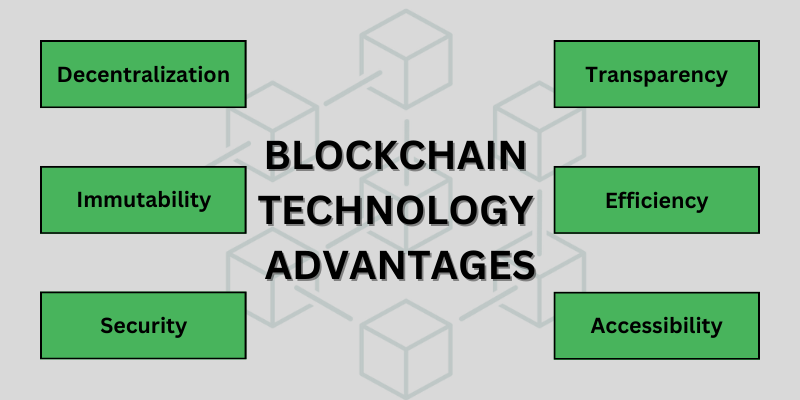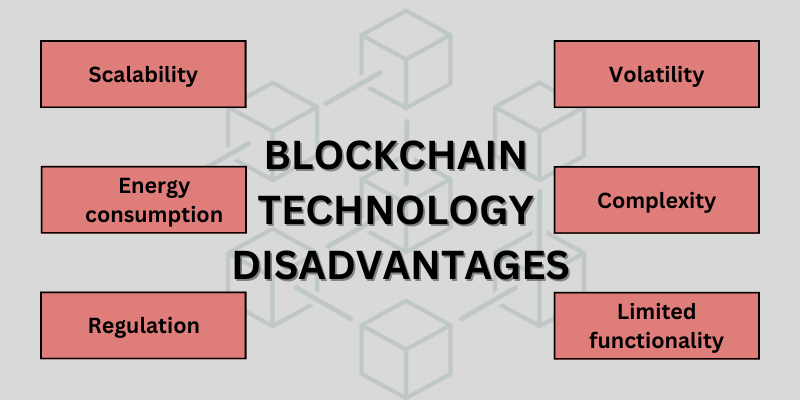Blockchain technology has gained immense popularity in recent years, with the potential to challenge various industries.
In this article, we highlight the main pros and cons of blockchain technology and explain blockchain technology.
Pros of Blockchain Technology
Let’s have a quick look at the advantages of blockchain technology:
- Decentralization: Blockchain eliminates the need for a central authority, empowering individuals and reducing reliance on trusted third parties. This fosters transparency and trust and reduces the risk of fraud or manipulation.
- Immutability: Once data is added to a blockchain, it cannot be altered or deleted. This ensures the integrity and authenticity of information, creating a reliable audit trail.
- Security: Cryptographic algorithms and distributed ledger technology make blockchain highly resistant to cyberattacks and data breaches.
- Transparency: All transactions on a blockchain are visible to participants, promoting accountability and reducing opportunities for corruption.
- Efficiency: Automating processes and eliminating intermediaries can streamline transactions and save time and cost.
- Accessibility: Anyone with an internet connection can participate in blockchain networks, promoting financial inclusion and global reach.

Cons of Blockchain Technology
Let’s have a quick look at the disadvantages of blockchain technology:
- Scalability: Current blockchain technology can struggle to handle large volumes of transactions, potentially hindering wider adoption.
- Energy consumption: Proof-of-work consensus mechanisms used in some blockchains require significant computing power, raising concerns about environmental impact.
- Regulation: The lack of clear regulations surrounding blockchain creates uncertainty and can hinder innovation.
- Volatility: Cryptocurrencies associated with some blockchains experience high price fluctuations, posing risks for investors and businesses.
- Complexity: Understanding and implementing blockchain technology requires technical expertise, which can be a barrier for some users.
- Limited functionality: While evolving rapidly, blockchain technology is still in its early stages and may not offer all the functionalities needed for complex applications.
It’s important to remember that blockchain technology is not a one-size-fits-all solution. Carefully evaluating its pros and cons in the context of specific use cases is crucial before adopting it.

What is Blockchain and How Does it Work?
Blockchain is a decentralized and distributed digital ledger technology that records transactions across a network of computers securely and transparently. It consists of data blocks containing a list of transactions and is secured through cryptographic hashes.
Once a block is completed, it is linked to the previous one, forming a chain. This chain structure ensures the integrity and immutability of the data. Transactions are verified by network participants through a consensus mechanism, preventing tampering.
Blockchain is the underlying technology for cryptocurrencies like Bitcoin and has diverse applications beyond finance, such as supply chain management and smart contracts.
What is Cryptocurrency, and How Does It Work?
Cryptocurrency is a digital or virtual currency that uses cryptographic techniques to secure financial transactions and control the creation of new units. Here’s a detailed explanation of how cryptocurrency works:
Decentralization
Cryptocurrencies operate on a decentralized network of computers known as nodes. Unlike traditional currencies, no central authority or government is regulating these currencies.
Blockchain Technology
The majority of cryptocurrencies utilize blockchain technology. A blockchain is a distributed ledger that records all transactions across a network. It consists of a blockchain, each containing a list of transactions. This decentralized and transparent system ensures the integrity of the currency.
Cryptography
Cryptocurrencies use cryptographic techniques to secure transactions and control the creation of new units. Public and private keys are generated for each user, ensuring secure ownership and transfer of assets.
Mining and Consensus Mechanisms
Cryptocurrencies often employ a consensus mechanism, such as Proof of Work (PoW) or Proof of Stake (PoS), to validate and confirm transactions. Miners or validators solve complex mathematical problems to add new blocks to the blockchain, ensuring the ledger’s integrity.
Peer-to-Peer Transactions
Cryptocurrencies enable direct peer-to-peer transactions without intermediaries like banks. Users can transfer funds directly to one another, promoting faster and potentially more cost-effective transactions.
Wallets
Users store their cryptocurrencies in digital wallets. These wallets can be hardware-based, software-based, or even paper wallets. Wallets store the user’s private keys, allowing them to access and manage their cryptocurrency holdings.
Limited Supply
Many cryptocurrencies have a capped supply, such as Bitcoin’s limit of 21 million coins. This scarcity can influence value and is often designed to mimic precious metals like gold.
Smart Contracts (in some cases)
Ethereum and other blockchain platforms support smart contracts, which are self-executing contracts with the terms of the agreement directly written into code. This enables programmable and automated contracts without intermediaries.
Anonymity and Privacy
While transactions are transparent and recorded on the blockchain, users are generally identified by cryptographic addresses rather than personal information, providing privacy.
Global Accessibility
Cryptocurrencies can be accessed and used globally, allowing individuals worldwide to participate in the financial system without traditional banking infrastructure.
Cryptocurrency works through a decentralized network, blockchain technology, cryptographic security, consensus mechanisms, and peer-to-peer transactions. It provides a secure, transparent, and potentially more efficient alternative to traditional currencies and financial systems.
Conclusion
Blockchain Technology is a decentralized ledger system that secures and records transactions across a network of computers using cryptographic techniques.
Blockchain technology offers a range of advantages, including decentralization, security, transparency, efficiency, and global accessibility. However, it also comes with challenges such as scalability issues, energy consumption concerns, regulatory uncertainty, transaction irreversibility, and a lack of universal standards.
FAQ
What are the main advantages of blockchain technology❓
Blockchain technology offers decentralization, immutability, enhanced security, transparency, efficiency, and global accessibility. It empowers individuals, reduces fraud, and fosters trust in transactions.
What are the disadvantages of blockchain technology❓
The cons of blockchain technology are scalability issues, energy consumption concerns, regulatory uncertainty, price volatility, complexity, and limited functionality for certain applications.
What is blockchain technology in simple terms❓
Blockchain is a secure method of recording information that prevents easy changes, hacks, or manipulation. A distributed ledger copies and shares transactions across a network of participating computers.
Is blockchain a good technology❓
✅ Yes. Blockchain increases trust, security, transparency, and the traceability of data shared across a business network – and delivers cost savings with new efficiencies.
How safe is blockchain technology❓
No financial system or data platform is accessible from security issues, and blockchain is no exception. Blockchains are not unhackable. It’s just complicated to damage them.